
General Sir John Coape Sherbrooke, was a British soldier and colonial administrator. After serving in the British army in Nova Scotia, the Netherlands, India, the Mediterranean, and Spain, he was appointed Lieutenant-Governor of Nova Scotia in 1811. During the War of 1812, his policies and victory in the conquest of present-day Maine, renaming it the colony of New Ireland, led to significant prosperity in Nova Scotia.

The Duke of Wellington's Regiment (West Riding) was a line infantry regiment of the British Army, forming part of the King's Division.
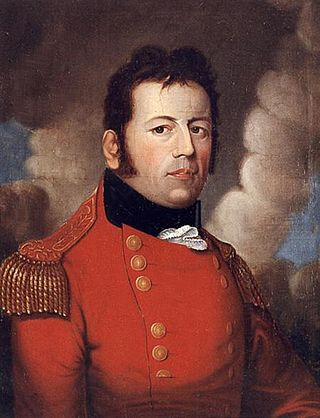
Sir George Prevost, 1st Baronet was a British Army officer and colonial administrator who is most well known as the "Defender of Canada" during the War of 1812. Born in New Jersey, the eldest son of Genevan Augustine Prévost, he joined the British Army as a youth and became a captain in 1784. Prevost served in the West Indies during the French Revolutionary Wars and the Napoleonic Wars, and was commander of St. Vincent from 1794 to 1796. He became Lieutenant-Governor of Saint Lucia from 1798 to 1802 and Governor of Dominica from 1802 to 1805. He is best known to history for serving as both the civilian Governor General and the military Commander in Chief in British North America during the War of 1812 between Britain and the United States.

Lieutenant General Sir John Gaspard Le Marchant (1803–1874) was a British Army officer and governor of Newfoundland from 1847 to 1852. He later became the Lieutenant Governor of Nova Scotia (1852–1858) and Governor of Malta (1858–1864).
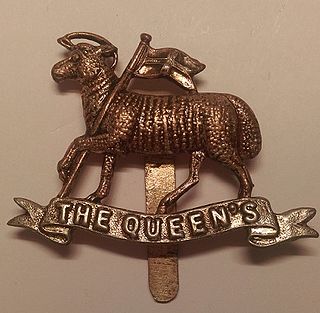
The Queen's Royal Regiment (West Surrey) was a line infantry regiment of the English and later the British Army from 1661 to 1959. It was the senior English line infantry regiment of the British Army, behind only the Royal Scots in the British Army line infantry order of precedence.
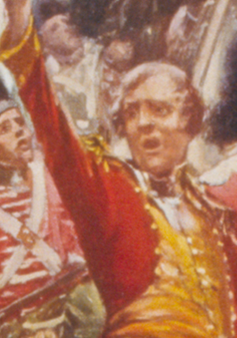
Lieutenant-General John Keane, 1st Baron Keane was an Irish soldier, whose military exploits in the First Anglo-Afghan War led to him being created Baron Keane of Ghuznee.
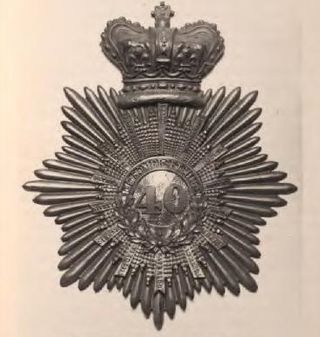
The 40th Regiment of Foot was an infantry regiment of the British Army, raised in 1717 in Annapolis Royal, Nova Scotia. Under the Childers Reforms it amalgamated with the 82nd Regiment of Foot to form the Prince of Wales's Volunteers in 1881.
The 62nd (Wiltshire) Regiment of Foot was an infantry regiment of the British Army, which was raised in 1756 and saw service through the eighteenth and nineteenth centuries. Under the Childers Reforms it amalgamated with the 99th (Lanarkshire) Regiment of Foot to form the Wiltshire Regiment in 1881.
The Battle of Hampden was an action in the British campaign to conquer present-day Maine and remake it into the colony of New Ireland during the War of 1812. Sir John Sherbrooke led a British force from Halifax, Nova Scotia to establish New Ireland, which lasted until the end of the war, eight months later. The brief life of the colony yielded customs revenues which were subsequently used to finance a military library in Halifax and found Dalhousie College.
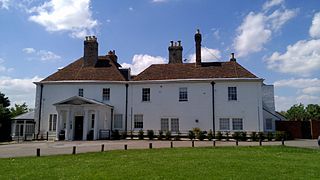
Mount Field was a cricket ground located at Ospringe on the south-western edge of Faversham in the English county of Kent. It was associated with The Mount, a large house built west of the ground, and was used for one first-class cricket match in 1876.
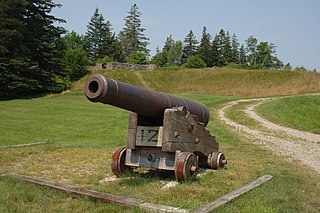
Fort George was a palisaded earthwork fort built in 1779 by Great Britain during the American Revolutionary War in Castine, Maine. Located at a high point on the Bagaduce Peninsula, the fort was built as part of an initiative by the British to establish a new colony called New Ireland. It was the principal site of the British defense during the Massachusetts-organized Penobscot Expedition, a disastrous attempt in July and August of 1779 to retake Castine in response to the British move. The British re-occupied Castine in the War of 1812 from September 1814 to April 1815, rebuilding Fort George and establishing smaller forts around it, again creating the New Ireland colony. The remains of the fort, now little more than its earthworks, are part of a state-owned and town-maintained park.
The 74th Regiment of (Highland) Foot or 74th Regiment of Foot (Argylshire Highlanders) was a British Army line infantry regiment from 1777 to 1784 which was raised to fight in the American Revolutionary War.

Nova Scotia is a Canadian province located in Canada's Maritimes. The region was initially occupied by Mi'kmaq. The colonial history of Nova Scotia includes the present-day Maritime Provinces and the northern part of Maine, all of which were at one time part of Nova Scotia. In 1763, Cape Breton Island and St. John's Island became part of Nova Scotia. In 1769, St. John's Island became a separate colony. Nova Scotia included present-day New Brunswick until that province was established in 1784. During the first 150 years of European settlement, the colony was primarily made up of Catholic Acadians, Maliseet, and Mi'kmaq. During the last 75 years of this time period, there were six colonial wars that took place in Nova Scotia. After agreeing to several peace treaties, the long period of warfare ended with the Halifax Treaties (1761) and two years later, when the British defeated the French in North America (1763). During those wars, the Acadians, Mi'kmaq and Maliseet from the region fought to protect the border of Acadia from New England. They fought the war on two fronts: the southern border of Acadia, which New France defined as the Kennebec River in southern Maine, and in Nova Scotia, which involved preventing New Englanders from taking the capital of Acadia, Port Royal and establishing themselves at Canso.

New Ireland was a Crown colony of the Kingdom of Great Britain twice established in modern-day Maine after British forces captured the area during the American Revolutionary War and again during the War of 1812. The colony lasted four years during the Revolution, and eight months during the War of 1812. At the end of each war the British ceded the land to the United States under the terms of the Treaty of Paris and the Treaty of Ghent, respectively.
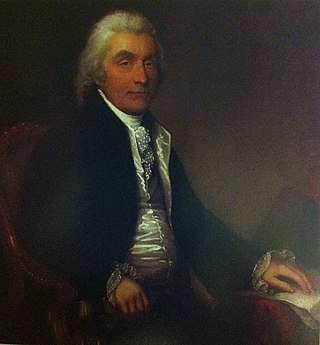
The Royal Nova Scotia Regiment was a battalion of infantry raised in 1793 to defend British interests in the colony of Nova Scotia during the Wars of the French Revolution. The unit was commanded by Colonel John Wentworth, the lieutenant-governor of the colony, throughout its existence. The Royal Nova Scotia Regiment (RNSR) had an undistinguished history through most of its existence, and saw very limited action, mostly in the role of marines, but did play an important role in the defense of Nova Scotia during these wars.

Brigadier General Francis McLean was a British army officer, one of two sons of Captain William Maclean and Anne Kinloch. He became famous for defending New Ireland (Maine) against the Penobscot Expedition during the American Revolution. The defeat of the Expedition was a noted British victory of the American Revolution. He was in command of the 74th Regiment of (Highland) Foot and 82nd Regiment of Foot (1778). He died 4 May 1781 at Halifax, Nova Scotia and is buried in the crypt of St. Paul's Church (Halifax). McLean never married.
Major-General Sir William Douglas was a Scottish officer in the British Army.
Admiral Thomas Le Marchant Gosselin was a British naval officer of the 18th and 19th centuries who received the patronage of senior officers such as Samuel Hood, 1st Viscount Hood and William Cornwallis. Gosselin joined the Royal Navy in 1778 and as a junior officer had extensive service in the American Revolution, including participating in the Battle of the Saintes in April 1782. Promoted to commander in April 1793, Gosselin took part in the Glorious First of June as commander of HMS Kingfisher. He was promoted to post-captain in July 1795 and took command of a variety of ships including most notably HMS Syren, HMS Latona, and HMS Audacious. Gosselin frequently served on blockade duties in the English Channel and on convoy duties to and from the West Indies.
General Sir Warren Marmaduke Peacocke KCH CTS KC was a British Army officer of the eighteenth and nineteenth centuries, most notable for his command of the Lisbon garrison during the Peninsular War. Peacocke joined the British Army in 1780, serving with a series of units before transferring to the Coldstream Guards in 1793. After having served as an aide de camp during the Irish Rebellion of 1798, Peacocke fought as a company commander with his regiment in the Egypt Campaign between 1800 and 1801, for which he was made a Knight of the Order of the Crescent by the Ottoman Empire. He subsequently served with the Coldstream Guards on the Hanover Expedition in 1805 and Copenhagen Expedition in 1807.
Lieutenant-General Sir Andrew Pilkington was a British Army officer who served through the Napoleonic Wars and War of 1812. He saw initial service fighting as a marine at the Glorious First of June in 1794 where he was wounded twice, and subsequently served with his regiment, the 2nd Regiment of Foot, at the Invasion of Trinidad in 1795. Having returned to Britain Pilkington helped defeat the Irish Rebellion of 1798 and in the following year was part of the Anglo-Russian invasion of Holland.













